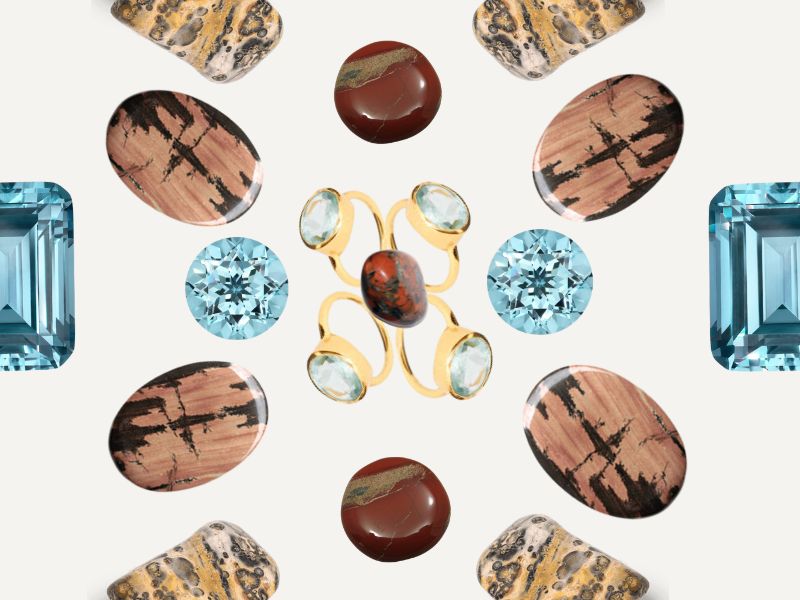
March Birthstones. And It's Not Aquamarine
Share
According to the Jewelers of America (formerly the American Jewelers Association), March has two official birthstones: aquamarine and bloodstone (heliotrope). However, this designation has only been in place for about 100 years. In 1912, the association standardized the list of birthstones, largely driven by commercial interests. Before this, jasper or bloodstone were traditionally associated with March across many cultures, while aquamarine was linked to October.
The reason for this shift lies in the marketability of gemstones. Both jasper and bloodstone are opaque, relatively inexpensive semi-precious stones, while aquamarine, in its fine jewelry quality, can be showcased in higher-end, luxurious settings. Adding aquamarine to March was likely a strategic move to cater to wealthier consumers born in this month.
Ultimately, the choice is yours: honor centuries-old mystical traditions or adhere to a 20th-century commercial reinterpretation. Let’s dive into the characteristics, symbolism, and historical significance of these three stones.
Jasper: The Stone of Protection and Harmony

In the 4th century, jasper was believed to ward off evil spirits and protect against poisonous bites. Bartholomew the Englishman wrote that the Greek and Latin name for jasper originated from a story about a stone found in the head of a venomous asp. He described jasper as a “miraculous” stone with as many virtues as colors and patterns it possessed. This aligns with traditions where the color of a stone was as vital as its chemical composition in determining its mystical and healing properties.
Each type of jasper has its own attributes:
• Black Jasper: Protects against negativity, both external and internal, safeguarding the owner from enemies and self-destructive tendencies.
• Blood Jasper (Red): Enhances intellectual abilities and aids in decision-making.
• White Jasper: Calms the mind, promotes positivity, and develops intuition.
• Green Jasper: Attracts financial luck, fosters intellect, and provides protection for infants, pregnant women, and mothers.
• Blue Jasper: A powerful tool for rituals and magical practices.
Jasper is also known for protecting homes—placing a small piece of it in a hidden corner is said to guard against theft, fires, and family conflicts. Additionally, jasper is believed to resonate with chakras based on its color, influencing energy balance.
Bloodstone: The Christian Legacy of Heliotrope

Bloodstone has long been associated with Christianity and is often mentioned in sacred texts. Legend has it that the stone was formed during the crucifixion of Jesus, as his blood dripped onto green jasper stones at the foot of the cross, leaving red stains. This belief linked bloodstone to divine sacrifice and redemption.
The occult world regarded bloodstone as a stone of extraordinary gifts, such as heightened intuition, spiritual insight, and truth-seeking. Alternative medicine promoted its use as a stimulant for the immune system and a natural detoxifier.
Bloodstone stimulates mental clarity and supports intellectual work, helping individuals make critical decisions with a clear mind. It is said to provide motivation when energy is depleted, reviving both mind and body. Metaphysical traditions also credit it with enhancing intuition, fostering creativity, and offering emotional support to those who feel isolated or rejected. Bloodstone is associated with the Muladhara (Root), Manipura (Solar Plexus), and Anahata (Heart) chakras, cleansing and energizing them.
Aquamarine: The Jewel of Clarity and Tranquility

As a member of the beryl family, like emerald, aquamarine has long been associated with clarity of thought, mental sharpness, and calmness. In Indian astrology (Jyotish), both emerald and aquamarine are linked to Mercury, the planet of intellect and communication.
Modern European lithotherapy considers aquamarine beneficial for the thyroid gland and emotional well-being. It is believed to relieve stress, ease fears, and quiet the mind. Aquamarine is also said to combat seasickness, making it a traditional amulet for travelers.
Other notable metaphysical properties of aquamarine include:
• Peace and Harmony: Known to reduce anxiety and promote emotional balance.
• Cleansing: Helps clear negative thoughts and emotions.
• Communication and Honesty: Enhances clarity in speech and fosters openness.
• Traveler’s Protection: Used historically as a talisman for sailors and travelers, guarding against storms and misfortunes.
• Intuition and Meditation: Supports intuitive insights and deepens meditative practices.
Aquamarine is associated with the Vishuddha (Throat) chakra, promoting clear communication and emotional stability.
Astrological Connections
According to Indian astrology, March spans the signs of Aquarius and Pisces. In Western astrology, it is predominantly associated with Pisces, with some overlap into Aries. Aquamarine, with its watery symbolism, is an obvious match for Pisces, a water sign. However, its planetary alignment with Mercury contrasts with Pisces’ ruling planet, Jupiter. This duality highlights the personal choice in selecting a birthstone—whether to follow planetary alignment or traditional symbolism.
Conclusion
Jasper, bloodstone, and aquamarine each offer unique qualities and rich histories. Whether you choose the grounding energy of jasper, the spiritual depth of bloodstone, or the calming clarity of aquamarine, the decision is yours to make. March’s stones truly reflect the diverse energies and traditions associated with this month.

Olga Bachurina,
Co-Founder of Venus in Libra,
Certified by GIA & Gübelin Academy